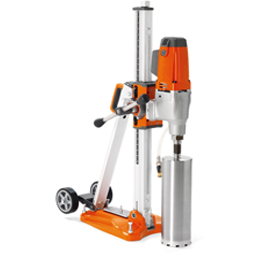The highly crucial projects involving concrete cutting and drilling come with different risks and hazards. Experienced people dealing with such projects understand those risks very well and are able to resolve them successfully.
Outlined below are some of the most common concrete cutting and drilling hazards along with their solutions:
a) Kick Back
This signifies violent or sudden movement of saws away from cutting surfaces, posing extreme risks for both bystanders and the operators. Different types of injuries may occur, including, bruises, fractures, cuts, and strains. Any contact with blade signifies lethal lacerations. There can be numerous causes for kickback, including the presence of unstable surfaces, embedded objects as pipes or wires, and cutting above the shoulder level.
Some of the precautions to minimise the chances of kickback include appropriate equipment selection and use of scaffold for projects over shoulder height. Careful consultation with the builders plan helps in avoiding embedded objects. Also, keep bystanders at a safe distance, away from an ongoing project and never circumvent or remove guards.
b) Inverted Cutting
It is important to take certain precautions related to inverted cutting to ensure smooth operations and keep hazards at bay. It involves cutting slab undersides, overhang, or floor. One should never undertake to do this using a hand-held saw since this affords little control on cutting machines present over shoulder height. Only, appropriately trained operators should undertake such projects that too using wall track-mounted saws. Never use water-cooled saws for such projects because water will flood inside the motor and create yet another hazard.
c) Noise Generation
Excessive generation of noise at the cutting site is another possible hazard. It may lead to damage of hearing because of extremely loud noise in short periods. Lower noise levels for lengthened periods may also create problems. It is important to implement control measures to keep the chances of damage to the hearing to a minimal.
For minimising or eliminating noise risks use saw noise-reduced blades, quietest blades and equipment, and gain information regarding equipment noise levels prior to purchase. Those who are not related directly to concrete drilling and cutting project should stay at least 7 m away from the job site. Use of hearing protectors is another precaution that can minimise the risks related to generated noise.
d) Gases & Dust
In order to deal effectively with gases and dust generation related to concrete cutting it is important to take the right precautions. While use of equipment for dust extraction and water suppression is ideal, it is not possible to apply them in all scenarios. If possible, use slower masonry and concrete drilling or cutting equipment, which generate minimal dust, if any. It is important to use respiratory guards at such project sites to keep health hazards at bay. Filter particulate respirators are a good choice since it gives protection against,
- Dust
- Fibres
- Lead Fumes
- Asbestos
- Silica
Silica dust is a major cause behind silicosis, chronic problem that leads to scarring and stiffening of the lungs. While symptoms are quite slow to appear it ultimately leads to health degeneration of the patient. Carbon monoxide gas emanating from concrete cutting sides is extremely hazardous. This odourless and colourless chemical asphyxiates, causes unconsciousness, rapid coordination loss, and even death. Respirators covered by OSH regulations are ideal for use in such environments.
e) Manual Tasks
Manual tasks related to concrete cutting projects bring with them a variety of hazards such as static or awkward working positions maintained/repeated for long periods of time. Trip and slip hazards or violent reactions of a different equipment are other problems that may crop up anytime. Use of proper support frames can minimise repetitions and holding of static positions. Whenever possible, try using lighter equipment, reduction in movement range, proper safety training for operators, and pre-check blades and different components.
f) Electricity
One cannot emphasise enough the hazards posed by electricity during concrete cutting. Pooled water always increases the chances of electrocution; therefore, its removal with dry or wet vacuum cleaner is necessary. In order to go for wet cutting always use petrol engine, hydraulic, pneumatic powered equipment and try avoid using those powered by electricity. Any electrical portable equipment in use should have protection against Earth leakage. Regular inspection and tagging of equipment with trained technicians is crucial too.
g) Vacuum Pressure Loss
Those who use vacuum assembly for anchoring stands of core drills are open to injuries if slurry, fills in the vacuum pump, leading to vacuum loss so that drill stand breaks free. In order to avoid this the operator should utilise bolt stands at least whenever possible. Use of sound surfaces for use of vacuum attachment is necessary, and so is monitoring of equipment on a regular basis to ensure vacuum pressure maintenance.


